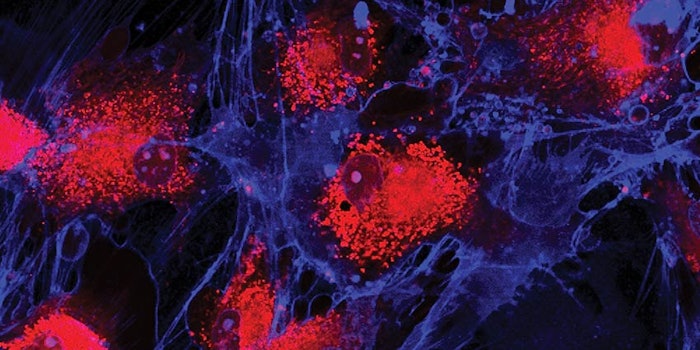
A cell is the smallest unit of life that makes up all living things. Cells are the building blocks of the body that carry out specific functions. They heal, repair and reconstruct the body. We have approximately 200 different types of cells and 30 to 40 trillion cells in the body. Cells communicate to regulate cellular functions and maintain homeostasis throughout the body. Homeostasis provides a stable environment despite external changes including temperature, bacteria invasion, sun exposure, diet and the natural aging process.
Communication is an important aspect when it comes to all relationships. The same goes for the relationship between cells in the human body. Without proper communication, body systems may not function properly. Communication between cells works by a signal molecule, called a ligand, binding with a receptor. A receptor is a molecule in which a ligand can attach to carry out an action. It is similar to a lock and key; the ligand would be the key and the receptor would be the lock. Cells are constantly sending and receiving messages, not only chemical messages, but mechanical and electrical as well. An example of mechanical signaling is in the case of muscle growth with exercise. Regulating heartbeat is an example of an electrical signal. The body is like one big communication network.
Think of cellular communication like the game telephone, where one person sends a message through a chain of people and the last one conveys the message they heard. If you’ve ever played the game, you would notice that communication isn’t always clear, and the wrong message is often delivered. The same can happen with signaling between cells. Body systems aren’t always functioning at their optimal level due to age, illness and/or external factors. This can cause mixed signals, over-communication or under-communication. For example, when keratinocytes aren’t healthy, they may send signals to the melanocytes to produce pigment even if there is no initial threat.
Receptors can be on the inside of the cell called intracellular or on the outside of the cell making it extracellular, depending on its solubility. For instance, peptide hormones can’t enter the cell since they are water-soluble; therefore, the receptors for these hormones are on the outside of the cell. Molecules that are hydrophobic or lipid-soluble can easily penetrate the cell membrane; therefore, the receptors are on the inside of the cell. An example of this would be steroid hormones.1
There are three steps to cell signaling. First is the reception, where the ligand (key) fits into the receptor (lock). The second step is transduction, the binding of the ligand and receptor activates intracellular molecules and triggers a change inside the cell. The final step is the response which produces the desired outcome. The outcome can be to influence one or more cellular processes including cell division, pigment production, collagen production, wound healing and to fight off infection.2
Types of Cell Signaling
Distant cells use endocrine signaling to communicate through the bloodstream. This is the way hormones in the body send messages to carry out specific actions. Another example of endocrine signaling is when cytokines message the brain to produce a fever when there are threats to the body.2
Paracrine Signaling is when one cell signals a neighboring cell. Paracrine signaling is especially important during development. One example of paracrine signaling is a bug bite reaction; cytokines release histamines which produces redness and swelling. Other examples are nerve cells that make muscles contract, tissue repair, wound healing, allergic skin reactions and blood clotting.
Autocrine Signaling involves a cell giving a signal to itself. It releases the ligand that binds to a receptor on its own surface. Autocrine signaling is used in development and is an important part of the immune system. When autocrine signaling is off- balance, it can lead to diseases including skin cancer.
Juxtacrine Signaling is direct contact between a signaling cell and a receiving cell. They must be adjacent cells. Juxtacrine signaling is present in the cells of the extracellular matrix triggering the production of collagen, fibronectin and other components.
Synaptic Signaling passes from nerve cells to another through neurotransmitters. They are similar to paracrine signaling, but there is a structure called a synapse, which is a junction between the cells. An example of synaptic signaling is between a neuron and a muscle controlled by neuron activity.
Cell Messengers
Any good communication has to be conveyed effectively; therefore, even cells need messengers to deliver their instructions.
Hormones. Hormones regulate bodily processes. They are chemical messengers in the body produced by the endocrine system and sent to specific organs or cells to carry out a definite action. For example, thyroid hormones can signal hunger to the brain or the opposite send the message that you are full. Hormones can tell a cell to grow, stop, and even change shape or function. A hormone imbalance can have varying effects on the body. A hypothyroid typically results in dry skin. Another example is testosterone, when levels are high, the skin can produce more sebum and lead to acne. Therefore, acne is commonly seen in teen boys during puberty when testosterone levels peak. Other conditions that occur from hormone imbalances can be much more serious, like Graves’ disease.
Cytokines. Cytokines are small proteins that are important for cell-signaling. They are secreted by a variety of cells including dendritic cells, T-cells, B-cells, fibroblasts, macrophages and mast cells. They bind to cytokine receptors on the surface of other cells and send immune messages to the nucleus to carry out an action. Cytokines include interleukins, lymphokines, interferons, chemokines, growth factors and many more. Cytokines are responsible for cell growth, differentiation, apoptosis, morphogenesis, metabolism and wound healing.
Growth Factors. Growth factors are a type of cytokine that promote cell survival, cell proliferation and cell differentiation. Growth factors are naturally occurring proteins or steroid hormones that are part of cell-signaling. Growth factors help with the growth of specific tissues and wound healing. They signal cells in the extracellular matrix to produce more collagen and elastin. For example, platelet-derived growth factor (PDGF) is released from platelets and binds to the PDGF receptors on fibroblasts signaling them to proliferate.
Exosomes. Exosomes are extracellular vesicles made within the cell that are also responsible for intercellular communication. These were originally considered cellular debris. They are released naturally from virtually every cell type. They are found in most biological fluids influencing immune responses, cell proliferation and neural signaling. Exosomes transfer messages with proteins and growth factors. The exosomes also carry mRNA, which is the template for building proteins. MicroRNA is also found in the exosome which is anti-inflammatory. Exosomes support the development of tissues including skin, muscle, hair, bone and cartilage. They boost the immune system, help with tissue regeneration and are wound healing.
Nitric Oxide. Nitric oxide is a simple gas that is used in cellular communication. It is a paracrine signaling molecule in the nervous, immune and circulatory systems. One role of nitric oxide is to signal the dilation of blood vessels stimulated by neurotransmitters. Instead of binding to a receptor, the nitric oxide alters target enzymes to send messages. Too much nitric oxide can result in inflammatory conditions, sepsis and carcinomas. When a damaged cell is not removed from the body it can be harmful to other cells. Apoptosis is when a damaged cell destroys itself to protect surrounding cells. Nitric oxide can promote or prevent apoptosis depending on instructions.3-4
Vitamins and Minerals. The cells also use vitamins and minerals to function and communicate effectively, and can either signal themselves or be involved in the signaling process. There are several nutrients needed by the body to operate effectively. Cell signaling can be off-balance with a lack of these nutrients. Certain vitamins and other ingredients can be used topically to benefit the skin. For example, vitamin A is an essential nutrient needed to keep the skin functioning at its optimal level. Cells have vitamin A receptors and when vitamin A, which would be the ligand, attaches to them, they carry out various actions to promote skin health. These include increasing cell growth, stimulating collagen and elastin, regulating sebum production and reducing the over-production of pigment. Vitamin A is known as a skin normalizer for this reason; it regulates the healthy function of cells.5-6 Vitamin A is a prime example, but there are several other ingredients that support signaling in the skin including vitamins B, C, and E, peptides and growth factors.7-8
Health and Communication
Communication is an important aspect of all bodily functions including those of the skin. Cell signaling helps the body maintain its pH, temperature and energy levels, which are vital to survival. The healthier we are, the better chance we have that the necessary signals are communicating as they should. The same goes for the skin. Feeding skin with nutrients and protecting it from external elements like excess sun exposure and pollution will promote its health and its appearance.9 Taking care of the body by supplying it with necessary vitamins and nutrients from food or other sources will help keep the cells communicating in a healthy state.Terri Wojak is a licensed esthetician with over 25 years of experience in the esthetic industry. She runs her own education company, Aesthetics Exposed Education, and is a master trainer for DermaConcepts. She has built over 50 individual courses, written more than 100 articles and published two books, Aesthetics Exposed: Mastering Skin Care in a Medical Setting & Beyond and Mastering Medical Esthetics.











